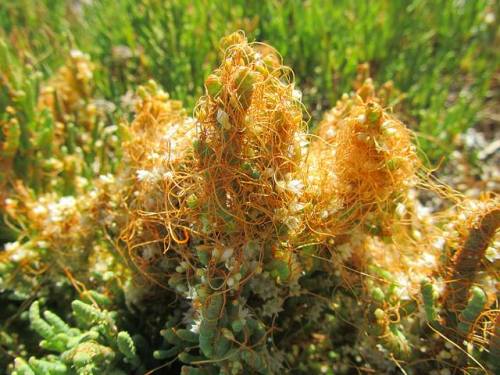rhamphotheca: Dodder (genus Cuscuta) This unique vine is a…
Thursday, October 10th, 2013
Dodder (genus Cuscuta)
This unique vine is a parasitic plant, incapable of supporting itself through photosynthesis. Most species are red, orange or yellow and lack much if any chlorophyll. They derive their sugars and nutrients from their host using haustoria, root-like structures that burrow into the tissues of the plant. They usually have a select number of host plants that they can rely on, and use volatile (airborne) chemicals produced by the host to locate them; some dodder species can be serious crop pests.
However, the seed needs to sprout nearby a suitable host – if the seedling doesn’t encounter a host plant within several days of germination, it will use up the stored energy in the seed and die. In temperate regions it is an annual, growing from seed each year; but in more tropical areas it can grow continuously and form heavy mats draped over trees or shrubs.
The vines have no obvious leaves (they’re tiny and appear scale-like), but do produce pale flowers early in the summer; pea-sized berries appear from mid-to late summer. Previously classified in its own family due to its unique characteristics and behavior, genetic studies now place it in the morning glory family. Species can be found throughout North America; this one is Saltmarsh Dodder (C. salina), which occurs west of the Rockies.
Photo by sfbaywalk on Flickr
(via: Peterson Field Guides)
When I’m leading a docent tour at the Carpinteria salt marsh I usually pull off a little bit of pickleweed with some saltmarsh dodder attached and pass it around. Lately, though, I’ve been having second thoughts about doing that.
Once when I was taking a tour led by one of the other docents, the other docent plucked a leaf gall from an arroyo willow and sliced the gall open with a thumbnail to reveal the sawfly larva inside. It was interesting, but it also condemned the larva to a lingering death. I didn’t say anything, but it saddened me. I don’t do that during the tours I lead.
When the lemonade berry is ripe I sometimes pull off a fruit and invite the group to taste it (fourth-grade marsh tour attendees unanimously agree: nothing at all like lemonade). I do the same with pickleweed (consensus: salty, and yeah, maybe a little like pickles). But picking the dodder for them to pass around makes me uncomfortable. Why is that?
There a lot of it in the marsh; the little I’m plucking is not going to make a difference. I show it to the group because I think it’s interesting up close (like in the photo above), especially when it’s flowering. It’s not some primitive moss or fungus; it’s a full-on flowering plant, albeit one with no green parts, no ability to photosynthesize. But it grows slightly off the trail, and rather than take the whole group down to the water’s edge I figure it’s better to bring some of the plant to the people, even if that means I’m killing that part of the plant just for the momentary educational benefit.
Maybe I feel okay about the lemonade berry and the pickleweed, but not about the dodder, because there’s a difference between removing part of a plant to eat it and doing so just to look at it.
Another aspect of the situation is this: with the sawfly larva, the whole organism was being killed in the name of satisfying a momentary curiosity. But when picking a piece of plant, the donor plant survives. Of course, that argument runs aground on my knowledge of things like dodders’ ability to regrow from a small piece of the plant, to say nothing of the knowledge that whole communities of smaller organisms live, Horton Hears a Who-like, on everything in the marsh.
I wonder if my feeling sympathetic toward the dodder is a result of my finding its obligate-plant-feeder lifestyle more familiar, and hence easier to identify with, than that of autotrophs like the pickleweed it grows on. We in the animal kingdom are all parasites in that sense; maybe this plant seems more animal-like to me, and hence more worthy of non-plucking consideration.
My brain is ridiculous.
The next time I do the tour I think I’ll have everyone walk off the path with me to observe the dodder in situ, rather than plucking it and passing it around. It’s a dumb thing that will only make a difference to me. But I think I’ll feel better.
Reposted from http://lies.tumblr.com/post/63691092362.
